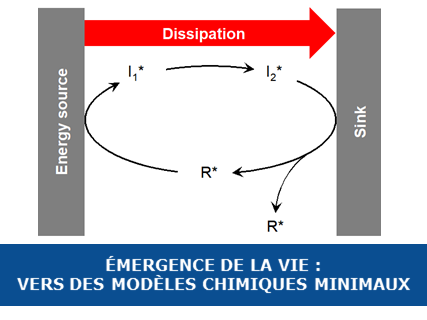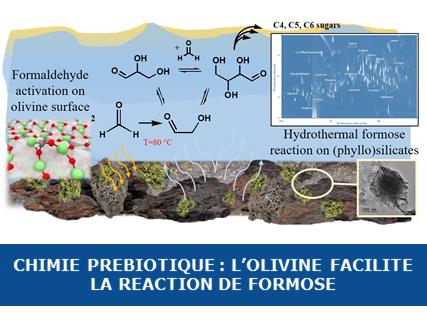Marie-Christine Maurel
Il est de plus en plus probable que les premières réactions biochimiques ont pu se dérouler sur des surfaces minérales. Il semble également que ces premières réactions présentaient des comportements élaborés et sensibles aux effets de l’environnement. Cet article introduit les notions de base sur le comportement des premiers catalyseurs et montre comment leur évolution peut être analysée à partir de leur comportement cinétique.
Pour en savoir plus :
Maurel & Ricard, 2006, The Evolution of Catalytic Function, Physics of Life
Téléchargez l’abstract au format PDF
It is very likely that the main driving force of enzyme evolution is the requirement to improve catalytic and regulatory efficiency which results from the intrinsic performance as well as from the spatial and functional organization of enzymes in living cells.
Kinetic co-operativity may occur in simple monomeric proteins if they display “slow” conformational transitions, at the cost of catalytic efficiency. Oligomeric enzymes on the other hand can be both efficient and co-operative. We speculate that the main reason for the emergence of co-operative oligomeric enzymes is the need for catalysts that are both cooperative and efficient. As it is not useful for an enzyme to respond to a change of substrate concentration in a complex kinetic way, the emergence of symmetry has its probable origin in a requirement for “functional simplicity”. In a living cell, enzyme are associated with other macromolecules and membranes. The fine tuning of their activity may also be reached through mutations of the microenvironment. Our hypothesis is that these mutations are related to the vectorial transport of molecules, to achieve the hysteresis loops of enzyme reactions generated by the coupling of reaction and diffusion, through the co-operativity brought about by electric interactions between a charged substrate and a membrane, and last but not least, through oscillations. As the physical origins of these effects are very simple and do not require complex molecular devices, it is very likely that the functional advantage generated by the spatial and functional organization of enzyme molecules within the cell have appeared in prebiotic catalysis or very early during the primeval stages of biological evolution. We shall began this paper by presenting the nature of the probable earliest catalysts in the RNA world.





Article très interessant.
A propos des argiles en tant que catalyseurs, je vous signale des travaux theoriques sur les aminoacyladenylates : Conformational analysis of aminoacyladenylates:a molecular orbital investigation, H.Broch and D. Vasilescu in « Biomolecular Structure, Conformation, Function and Evolution » Ed. R. Srinivasan, Pergamon Press, New York, 1980, pp. 329-343 et d’autres articles que nous avons publiés à la même époque tel : Implication of aminoacyladenylates conformations in the prebiotic polypeptide synthesis H. Broch, D. Cabrol and D. Vasilescu, Int. J. Quantum Chem. QBS 8, 139, 1981 Des travaux sont en cours ,pour poursuivre, avec des methodes quantiques plus puissantes que dans les années 80, l’analyse conformationnelle des aaAMP en relation avec leur insertion dans les aa-t RNA synthetases. Sentiments cordiaux Dan Vasilescu , Prof. Emérite, LUAN, Univ. de NICE